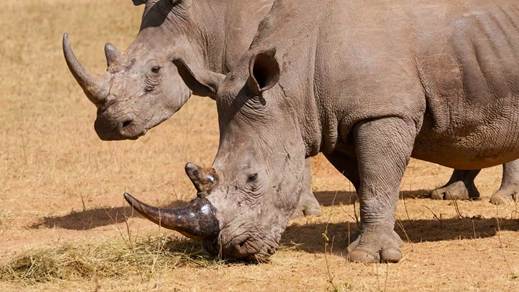
Written by BlogsoneAugust 5, 2025
Try and Save Rhinos by Giving Them Radioactive Horns
Current Affairs Article
Context: Rhisotope Mission (South Africa)
- What? A novel anti-poaching initiative utilizing radioactive isotopes injected into rhino horns.
- The place? Waterberg Biosphere Reserve, South Africa.
- Who? Led by the College of the Witwatersrand, supported by the IAEA (Worldwide Atomic Power Company).
Relevance: GS 3(Surroundings and Ecology)

Goal and Objective
- Curb Unlawful Wildlife Commerce: By making horns detectable, ineffective for poachers, and harmful for illicit commerce.
- Keep away from Animal Hurt: Process goals to retain the horn (in contrast to dehorning) whereas not harming the rhino.
- Leverage Nuclear Safety Instruments: Makes use of current Radiation Portal Displays (RPMs) at borders, ports, and airports to detect the isotope-tagged horns.
How the Expertise Works: Radioisotope Tagging
- Non-Invasive Method: Low-dose radioactive isotopes are injected with out surgical procedure or structural adjustments.
- Mechanism:
- Isotopes emit low radiation, absorbed by keratin (horn materials).
- This makes horns simply detectable utilizing RPMs, even in containers.
- Mimics unlawful nuclear materials transport — already tracked globally.
- Security Verified:
- Trials on 20 rhinos in June 2025.
- Cytological (cell-level) exams by Ghent College, Belgium.
- In contrast 15 handled and 5 untreated rhinos — no organic injury discovered.
- Horn Turns into “Toxic” to people as a result of radioactive properties – deterrence by well being threat.
Mission Particulars
- Title: Rhisotope Mission
- Value: ~$290,000
- Timeframe: 6 years of improvement and testing
- Worldwide Collaboration: IAEA, Ghent College (Belgium), and so on.
Significance for World Conservation
- Poaching Disaster:
- 500,000 rhinos at begin of twentieth century → ~27,000 in the present day.
- Poaching pushed by demand for rhino horn (conventional drugs, standing image).
- Present Technique Limitations:
- Dehorning: Worrying and invasive.
- Militarized anti-poaching items: Costly and confrontational.
- Demand-side regulation: Gradual and ineffective within the quick time period.
- Radioisotope Strategy:
- Non-lethal deterrence for people.
- No hurt to rhinos.
- Makes use of current worldwide safety infrastructure (nuclear materials monitoring).
India-Particular Relevance & Moral Dimensions
Conservation Classes for India
- India faces comparable threats (e.g., tigers, elephants, pangolins).
- Kaziranga and Manas Nationwide Parks have suffered rhino poaching.
- Rhisotope-like methods might complement:
- Mission Tiger / Mission Elephant / Mission Rhino
- CITES enforcement, NTCA monitoring techniques
Moral & Authorized Concerns
- Is it moral to make use of radioactive substances on animals?
- Supporters argue: If confirmed secure, it saves lives with out hurt.
- Might require revision of home legal guidelines to permit such radioactive use on wildlife.
- Wants public acceptance, scientific transparency, and regulatory oversight.
Worldwide Cooperation & Expertise Switch
- Mission reveals profitable mannequin of science diplomacy in conservation.
- India might:
- Collaborate with South Africa for technical know-how.
- Suggest comparable instruments for pangolin scale monitoring (subsequent huge unlawful wildlife commerce).
- Search IAEA, UNEP partnerships beneath South-South cooperation.
Crucial Insights & Coverage Implications
- Technological innovation is rising as a important conservation software.
- Nuclear tech repurposed for peacetime wildlife safety – new frontier.
- Emphasizes deterrence by traceability, not simply bodily limitations.
- Demonstrates the significance of interdisciplinary options — mixing wildlife science, nuclear physics, ethics, and regulation.
Conclusion
The Rhisotope Mission represents a groundbreaking shift in anti-poaching methods — one that’s non-violent, tech-driven, and globally built-in. Whereas not a silver bullet, its capability to behave as a deterrent with minimal animal hurt makes it a compelling mannequin for India and different biodiversity-rich nations dealing with comparable threats.
Leave a Reply